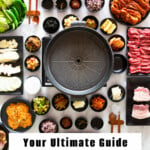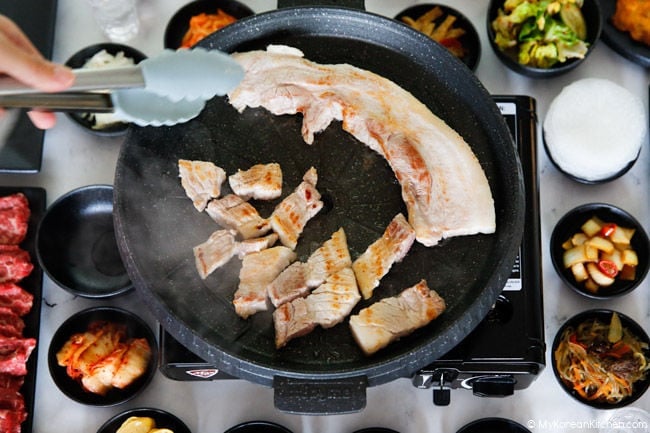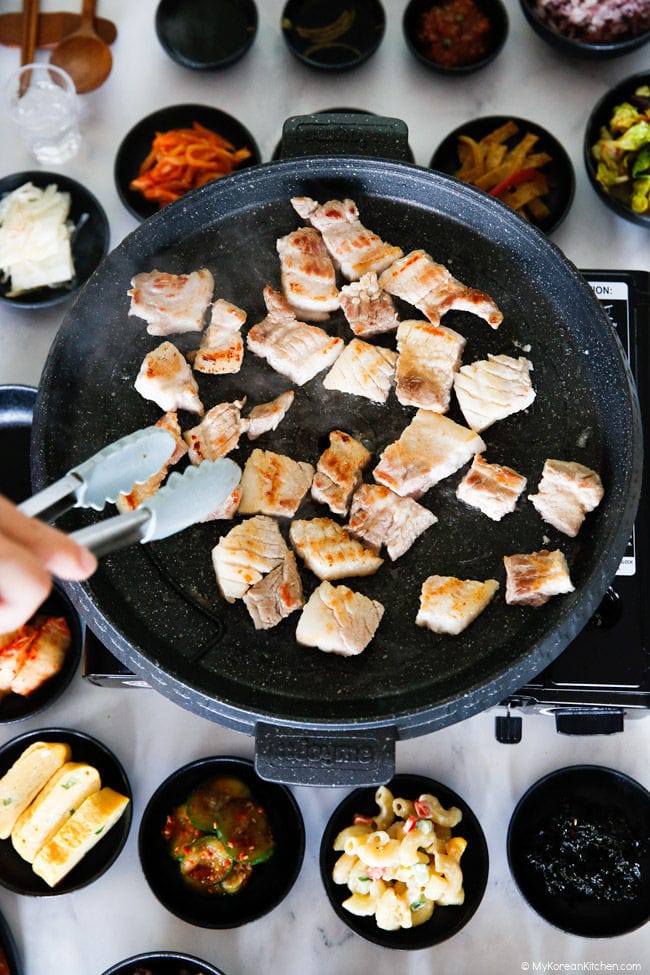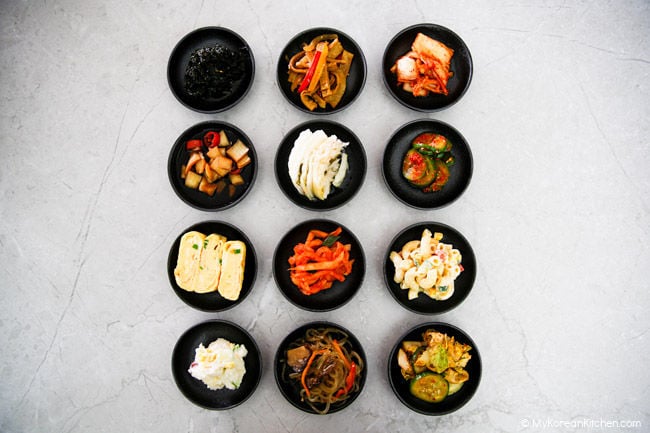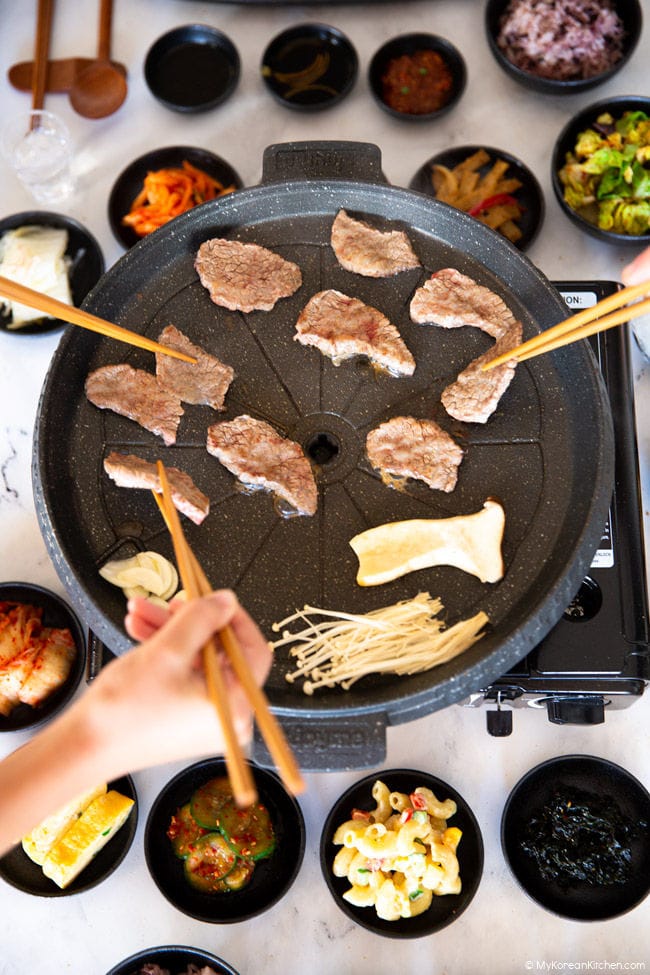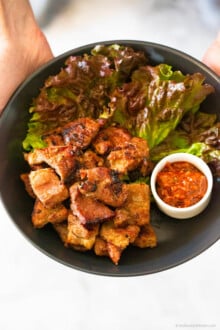Learn how to host an amazing Korean BBQ at home! Invite your loved ones and treat them to this truly unique culinary experience.
This guide contains all the information you need to set up a successful DIY Korean BBQ. You’ll discover which meat to buy, how to prepare it, and which mouth watering side dishes to serve.
Before you know it, you’ll be savoring the incredible flavors of Korean barbecue and enjoying a full and satisfied stomach!

What is Korean BBQ
KBBQ, which stands for Korean barbecue, is a widely enjoyed way of grilling meat.
Many Korean barbecue restaurants often feature built-in grills located in the center of the tables, which allow diners to cook their own food right at the table. This design highlights the communal nature of the Korean dining culture. By cooking the food at the table, it enables a more interactive and enjoyable dining experience with friends and family.
The BBQ process often also involves marinating the meat before grilling in a blend of delicious sauces like soy sauce, sesame oil, and Korean pear, which will bring out one of the best flavors you’ll ever experience.
They are then served with various side dishes, such as kimchi, leafy greens, dipping sauces, and other dishes that will undoubtedly enhance your enjoyment.
Korean BBQ Meat
To fully enjoy Korean BBQ, it’s essential to choose the right type of meat. Whether it’s beef, chicken, or pork, there’s a variety of red and white meats available that can make for a delicious Korean barbecue experience.
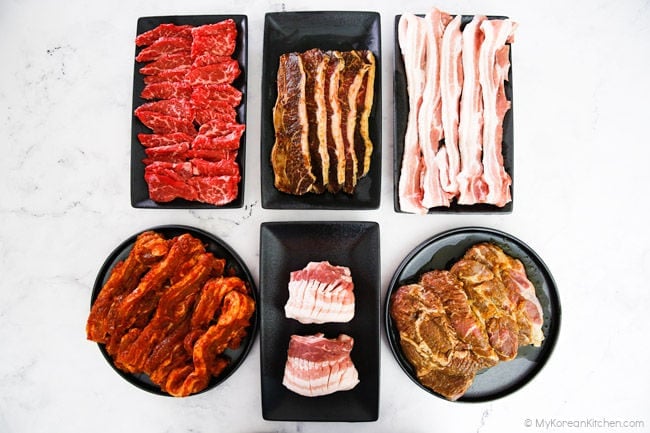
Some popular Korean BBQ meat includes:
Beef
Bulgogi (불고기) – Bulgogi is a famously delicious Korean dish usually made with thinly sliced and marinated beef, such as ribeye and sirloin steaks. The secret to its scrumptiousness lies in the marinades and quick grilling, which seals in the meat’s natural sweetness and savoriness. It can also be stir-fried with some vegetables for another delicious way to enjoy it.
Galbi / Kalbi (갈비, Beef Short Ribs) – Galbi / Kalbi refers to ribs (often beef short ribs), which is a popular cut of meat in Korea. Yangnyeom Galbi / Kalbi (양념갈비) is marinated beef short ribs in a delicious sweet and savory sauce. The meat has been prepared by butterflying it into a long and thin flap that remains attached to the bone. This makes it easier to marinate and cook on a BBQ grill. Additionally, the seasoned meat is tender, sweet, and slightly salty, which makes it irresistible.
You could also consider grilling boneless short ribs, also known as galbisal (갈비살). This cut is typically grilled without marinade and may be labeled as beef rib fingers or intercostals by some butchers.

Another popular galbi cut is LA Galbi, which is cut through the rib bone, usually displaying three “rib bone eyes”. This cut of meat is also often marinated before grilling.
Chadol Baegi (차돌박이, Brisket) – This non-marinated, super-thin cut of beef cooks very quickly. A popular way to eat it is by dipping it in a savory salt, pepper, and sesame oil dipping sauce. It can become tough and chewy easily if overcooked, so be careful not to overcook it.
Pork
Samgyeopsal (삼겹살, Grilled Korean Pork Belly) – Korean pork belly, Samgyeopsal or Samgyupsal, is a popular meat that is commonly grilled without marination.
Though there are many restaurants that specialize in marinated pork belly, such as those with red wine, Korean soybean paste (doenjang), and a gochujang-based sauce, in particular, gochujang marinated pork belly creates a delicious and addictive spicy pork Korean BBQ.
After grilling, the pork belly is usually cut into small pieces and eaten with pajeori (Korean green onion salad), ssamjang (spicy dipping sauce), and grilled kimchi in a lettuce wrap.

Moksal (목살, Grilled Pork Collar Butt) – Moksal is a great cut of pork that can be grilled with or without marinade. Without marinade, it has a taste and texture similar to Korean pork belly (samgyeopsal), but it has less fat and more meat. This cut is also a popular alternative to butterflied pork ribs, which can be harder to find, more expensive, and takes longer to cook. Try this recipe –Korean BBQ pork; it involves a delicious soy sauce based marinade that you simply must try!
Chicken
Chicken Bulgogi – Chicken bulgogi is a delightful take on the traditional bulgogi. The most ideal cut of chicken to use is the thigh, as it is both tender and flavorful. By marinating the chicken in bulgogi sauce, you create a delectable Korean BBQ dish.
Gochujang Chicken – This Korean chicken dish is a delicious and flavorful alternative to soy-based chicken bulgogi. Simply marinate chicken thighs in a blend of gochujang (Korean chili paste) and other flavors, then grill them on a BBQ. The gochujang sauce gives the chicken a perfect balance of spice and savoriness, making it your new favorite BBQ dish!
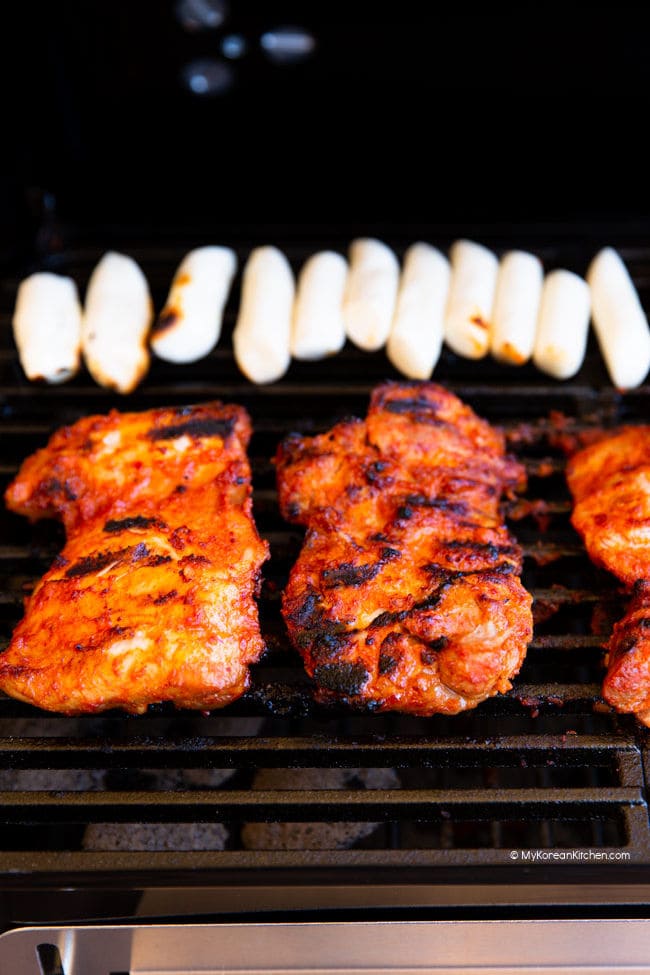
Where to Buy Korean BBQ Meat
If you’re in the market to buy cuts of meat for a Korean BBQ, there are a few places you can get it.
Option 1.
In the U.S., Korean grocers such as H-Mart carry these types of meats. Hanaro Mart in Australia is similar to H-mart, but on a smaller scale. Many other Korean grocers will also carry some form of Korean BBQ meat.
Alternatively, if you live near a large Korean community, there may be a local Korean butcher from which you can source as well.
Option 2.
Some Asian grocers offer a selection of Korean meat products, although the range of items available is often limited compared to dedicated Korean grocery stores. Despite that, Asian grocers are a convenient option for people who want to find Korean meat cuts or other ingredients to make Korean BBQ.
Option 3.
Depending on the cuts of meat you’re after, some of them may be available at a regular grocery store or butcher. Moreover, you have the option of either cutting the meat into your preferred style using your own tools at home or requesting your butcher to do it for you.
Korean BBQ Grill, BBQ Tools and Utensil
Korean BBQ Grill
If you’re new to cooking Korean BBQ at home, it may seem challenging. However, using specialized grills and tools can simplify the process.
There is a vast selection of products available on the market that are designed to make KBBQ preparation much easier.
Korean BBQ grills and plates come in various shapes, the most common being square, round, or dome shape. Most of them have a channel specifically for catching and draining the oil from the meat, which helps to keep the dish tastier and healthier.
You should find these grill and plate sets at local Korean grocery stores or online retailers, such as Amazon.
Selecting the right Korean BBQ grill is essential if you want to enjoy some delicious and juicy grilled meat. Make sure to think about what type of meat you want to cook, how well it will fit into your stove and whether it can be easily cleaned after each use. Also, it’s worth noting that certain grills work better for specific types of meat. For instance, some grills are more appropriate for marinated meat than non-marinated meat.
Lastly, some grills have divided sections, where you can conveniently cook items like cheese or egg omelettes without them touching the meat.
If you would like more information on Korean BBQ grills, please refer to my article – Korean BBQ grill.
Keep in mind that indoor grill brand availability varies by country. Popular options in the U.S. include Techef and Iwatani, while in Korea, brands such as Kitchen Art and Queen Sense are more commonly used.
Best of luck in your search!
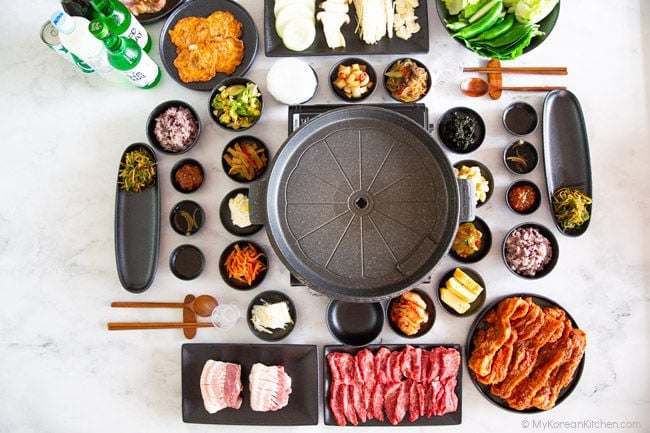
Heat Source
When you are selecting a grill, you should also consider the heat source. Depending on the type of heat source used, it can drastically affect the cooking temperature, cooking time and performance of your grill.
- Charcoal is the traditional way to get that great smoky flavor, but it’s not the most practical option if you want to cook indoors. Additionally, it takes more time to set up and clean afterwards.
- Induction Cooktops are a safe and easy option for cooking, but not all Korean BBQ grill plates are compatible with induction. Before purchasing a grill, make sure to check if it is induction compatible.
- Portable Butane Stove is a great option for indoor cooking (be sure to have good ventilation) and my preferred method as it’s more convenient to use. You can find some models with a built-in grill, but I recommend getting a separate stove and grill. That way, the grill pan will be easy to clean and your replacement cost will be cheaper if something fails.
No matter what grill you use for your Korean BBQ party, you’ll want to keep a window open because things will get smoky. Additionally, grilling can cause oil splashes onto adjacent items; thus, it would be prudent to cover those objects with a tablecloth or remove them before beginning to grill.
Utensils – Tongs & Scissors
Make sure to have some essential tools when grilling Korean BBQ at home. You can use tongs to flip the meat without causing a mess and scissors to cut larger pieces into smaller portions.
I find that tongs around 20 to 25 cm in length work well. It’s also a good idea to have multiple tongs to keep cooked meat separate from raw meat.
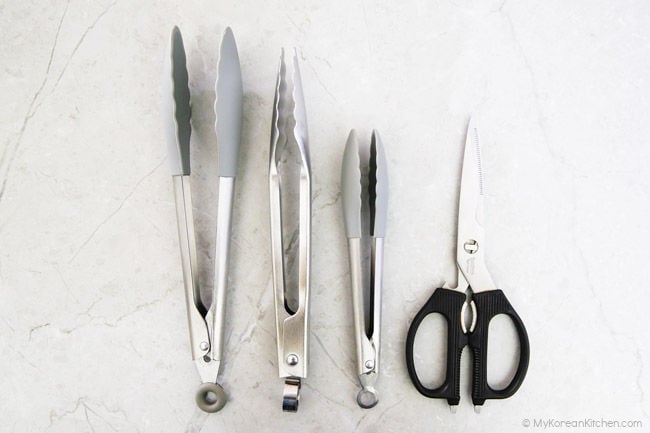
How to Make Korean BBQ
For a successful Korean BBQ night, prepare ahead of time by marinating your meats (if you are using marinated meat). Don’t forget to also prepare staple side dishes, such as kimchi, pickled radish and sauces. You can either make these yourself or purchase them from a local Korean grocer.
Set up your banchan (Korean side dishes), dipping sauces, and other ingredients on the table before cooking the meat so that, as it gets cooked, you can start eating right away.
To cook Korean BBQ, heat up your grill or hot plate, making sure the windows are open if you’re cooking indoors. Brush some oil on the grill, or rub the fattiest meat on the grill instead. When the grill is hot, add slices of meat. Flip as needed – but if you flip too much, it will lose flavor.
Cut the meat into bite-size pieces using scissors. As the pieces get cooked, take them off the grill and wrap them with wrapping ingredients. Top with a dipping sauce and enjoy! After that, repeat the process of cooking and eating. For more detailed grilling tips, see below.
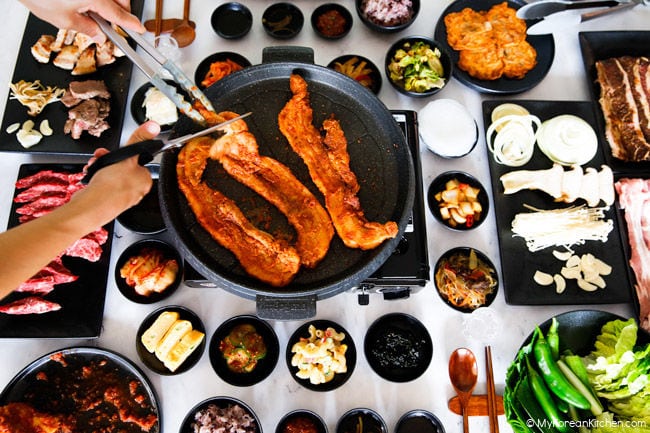
How to Grill Korean BBQ
If you’re grilling multiple types of meat, it’s best to grill the non-marinated ones before the marinated ones. This will minimize smoke and prevent the grill from burning too quickly.
Start placing the meat in the middle of the grill. This is because that is where the meat cooks most evenly. To keep juice loss at a minimum, don’t flip it too much. As with any other BBQ, the more you turn it over, the more it loses its flavor and it also becomes drier. Start moving the meat off the grill as it cooks or move it to the edge of the grill, so it cooks at a slower pace.
At a Korean BBQ restaurant, the servers will replace your grill often to ensure that your meat is always cooked at its best condition. However, it’s not very practical to change the grill or plate at home. To maintain your grill in the best condition during grilling, wipe it with paper towels when it becomes too greasy or there is some burned charcoal.
Although the majority of this guide’s instructions are geared towards indoor BBQ using a Korean BBQ grill, you can still cook your meat on an outdoor grill by following your manufacturer’s instructions.
While an outdoor grill doesn’t offer the same communal dining experience as a traditional Korean BBQ grill, we still use our Weber BBQ occasionally to cook marinated Korean BBQ, which tastes equally incredible. The extra chargrilled flavor and texture is comparable to the ones you would find at a Korean charcoal BBQ restaurant.
Korean BBQ Vegetables
Korean BBQ isn’t complete without the addition of grilled vegetables. Typically, you’ll find five options at a Korean restaurant: Grill these items in a designated corner on your grill plate for an irresistible meal!
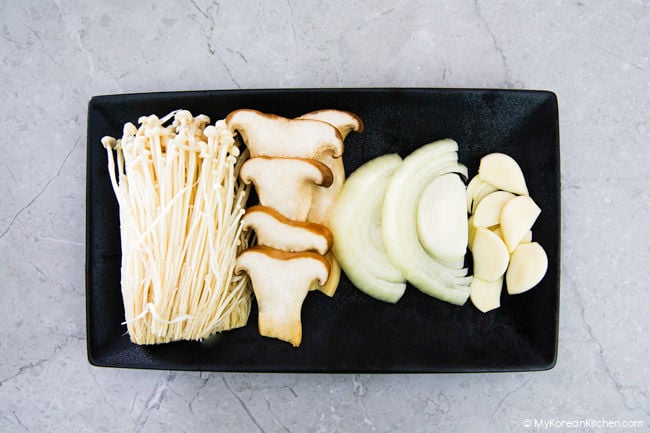
- Garlic: I generally don’t enjoy eating raw garlic, but I absolutely love it when it’s grilled with Korean BBQ. The savory, aromatic flavor of garlic really enhances the pleasure of having BBQ, and there are times when I enjoy it even more than the actual meat! Just peel the skin, thin-slice, and grill it.
- Onion: Grilled onions are a delicious addition to Korean BBQ just like grilled garlic. They’re easy to cook and add a nice aroma and texture to your KBBQ.
- Chili: Sliced green chilis are often cooked on the barbecue grill. Some people believe that grilling reduces their spiciness. If you enjoy eating chili and Korean barbecue, you may enjoy the unique flavor it adds.
- Mushrooms: I love grilled enoki mushrooms. They have a texture that can be either juicy or crunchy depending on how much oil they soak up. Personally, I prefer them to be slightly crunchy, like a hash brown. Other popular mushrooms for grilling include King oyster mushrooms.
- Kimchi: Barbecuing kimchi transforms it into an entirely unique dish with delightful flavor! Korean restaurants sometimes serve kimchi that is one year old. Though it might sound intimidating, this type of kimchi is actually less strong in its smell and taste when cooked. Moreover, it is incredibly tasty!
Korean BBQ Side Dishes
Korean BBQ is not complete without the essential accompaniments of wraps, dipping sauces, side dishes and rice. Keep reading to discover more about each one of these staples!
Wraps
Koreans typically enjoy meat wrapped in leafy greens, with the first two being particularly popular. These greens are usually served at Korean restaurants.
- Korean Lettuce (Sangchu, 상추) – This looks very similar to baby cos lettuce (romaine lettuce). Typically, they are either completely green or have some shades of reddish-purple over the green leaves. I don’t have much opportunity to get fresh Korean lettuce where I live, so I normally buy baby cos lettuce from a local grocery store or at a farmers’ market.
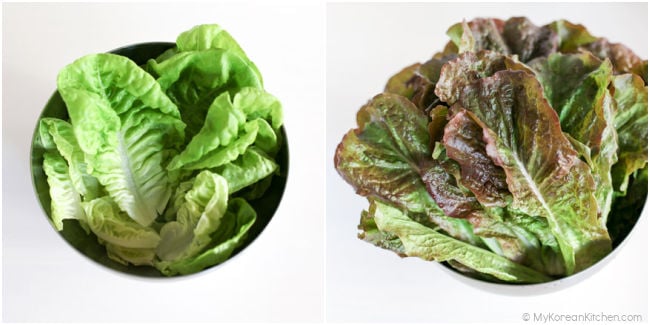
- Korean Perilla Leaves (Ggannip, 깻잎) – The perilla plant is one of my favorites for its distinctive herbal taste. It has large, flat leaves that are dark green with a strong fragrance. Perilla is part of the mint family, but does not taste minty. In fact, its leaves are often mistranslated as sesame leaves but they come from different plants entirely.
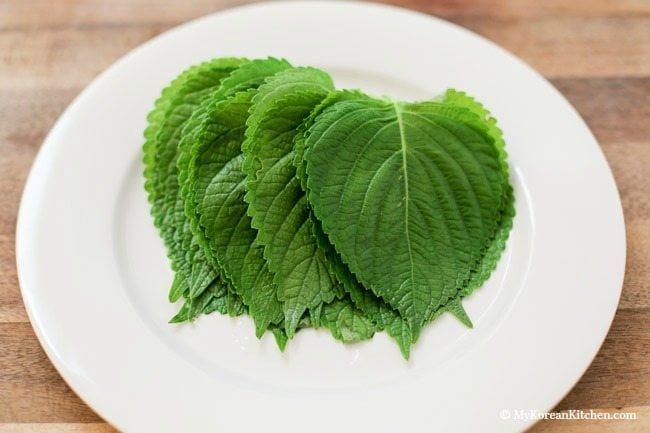
- Chicory – Chicory is a type of vegetable renowned for its bitter taste. It comes in various colors and shapes, and the flavor can differ slightly depending on the variety. When included as part of a wrap, it is usually layered with Korean lettuce and/or Korean perilla leaves to provide a hint of bitterness.
- Bok Choy Leaves – Some restaurants offer bok choy leaves, along with other leaves, which can be used to make wraps or for dipping in the provided sauce and eating them raw.
Korean BBQ Dipping Sauces
Korean BBQ would be incomplete without a Korean BBQ dipping sauce, and luckily, there are many delicious varieties to choose from. Here, I showcase three of the most popular options for your next BBQ!
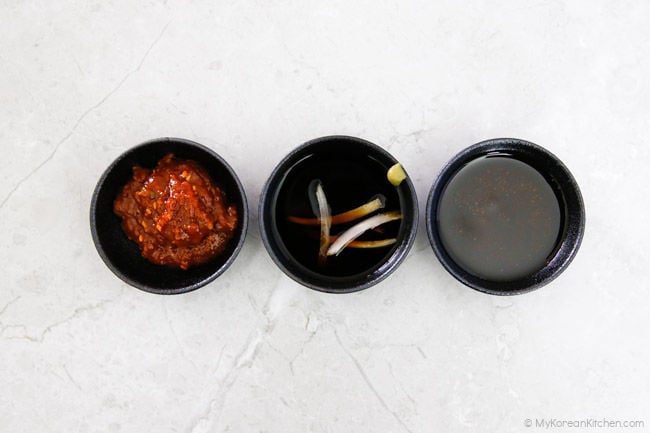
Ssamjang (Korean Spicy Dipping Sauce)
Ssamjang (쌈장) is a Korean paste that is thick and spicy, usually made with Korean soybean paste (DoenJang, 된장), Korean chili paste (Gochujang, 고추장), minced garlic, minced onion, chopped green onion, and sesame oil. You can easily make it at home or buy it from a Korean grocery store. For the recipe, check out my Ssamjang recipe.
Wasabi and Soy Sauce
If you want a delicious sauce to go with your char-grilled, marinated pork or beef (known as Sutbul Galbi, 숯불 갈비), this sauce is perfect. It’s made with wasabi, soy sauce, sugar, and vinegar; giving it a sweet and tangy taste.
You won’t find this sauce in stores, but you can make it from scratch in just one minute.
For the recipe, check out my Korean BBQ dipping sauce recipe.
Sesame Oil, Salt and Pepper Sauce
If you’re looking to liven up your barbecue without marinating, this savory sauce is the perfect choice. All it takes are a few ingredients—salt, pepper, and sesame oil—to elevate your samgyupsal (Korean grilled pork belly) or any other non-marinated grilled meat.
For the recipe, check out my Korean BBQ dipping sauce recipe.
Korean Side Dishes
You won’t really feel the need for Korean side dishes when you eat Korean barbeque at home, but they greatly enhance the overall culinary experience. So, here we go. Below are some of my suggestions.
- Korean Green Chili (Put-Gochu, 풋고추) – Koreans love chili peppers, particularly the non-spicy variety. You just dip them into ssamjang, a Korean spicy dipping sauce, and munch down on them like carrots or cucumber sticks. It doesn’t have a strong taste and has a nice crunchy texture.
- Cucumber (오이) – Koreans enjoy fresh cucumber sticks with ssamjang sauce. To eat, simply dip the cucumber into the sauce! This is a light, refreshing, and satisfying snack while you wait for your BBQ meat to cook.
- Korean Pickled Radish (Ssam-Mu, 쌈무) – Korean BBQ enthusiasts often serve pickled radish alongside their meat dishes; this side dish provides a delightful, tangy, and sweet flavor as well as a crunchy texture. Pickled radish complements any type of Korean BBQ meat; you can buy it at a Korean grocery store (usually found in the refrigerated section), or make it yourself with just a few simple ingredients.
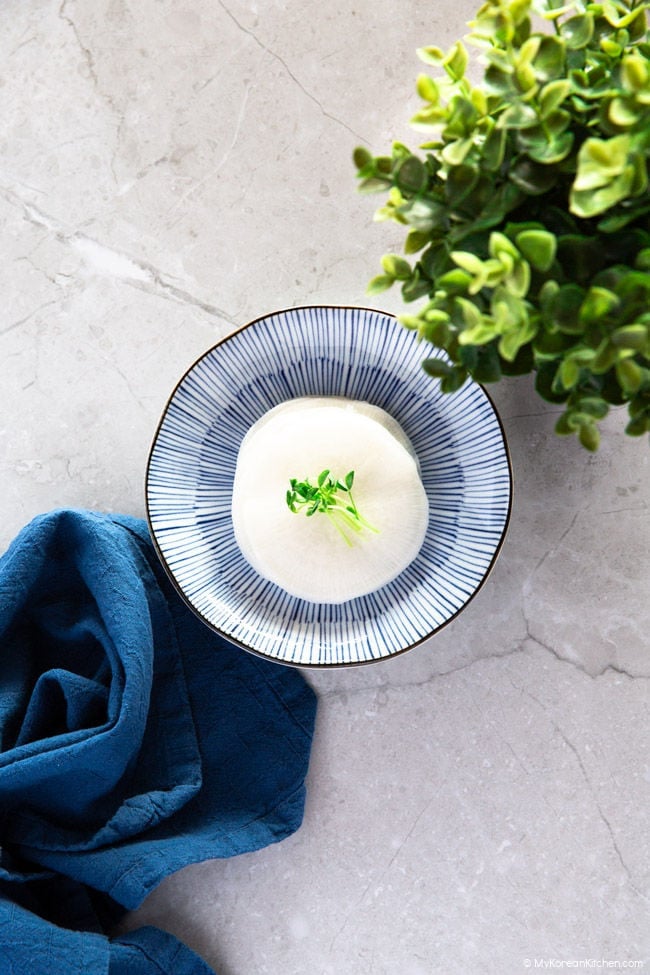
- Kimchi (김치) – Kimchi is a traditional Korean dish created with napa cabbage, and it is the perfect accompaniment for any Korean meal. It is spicy and sometimes pungent; it will spice up your dining experience with its distinctive flavor!
- Dongchimi (Water Kimchi) or Nabak Kimchi (나박김치) – Dongchimi and Nabak kimchi are two classic types of Korean radish water kimchi that pair perfectly with a traditional Korean BBQ feast. The light, crisp flavors of the former is a refreshing contrast to grilled meat dishes while the latter contains just enough heat to tantalize your tastebuds.
- Korean Green Onion Salad (Pajeori, 파절이) – This salad dish is commonly served with Korean pork BBQ and is sure to not disappoint. Its unique combination of sweet, tangy, and spicy flavors, coupled with the aromas of green onions, creates an unforgettable dining experience.
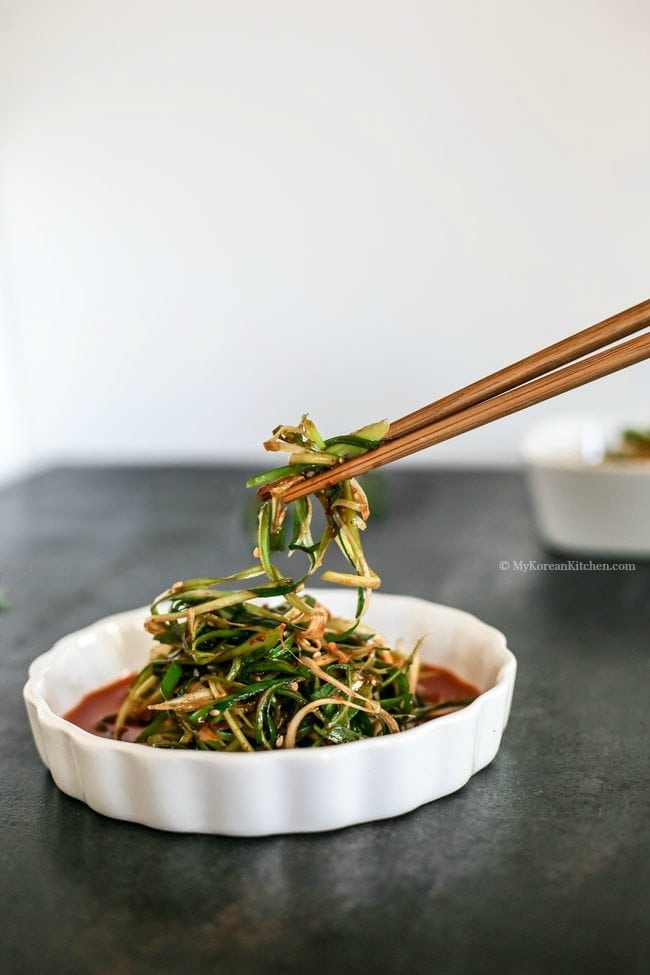
- Pickled Onions (양파 장아찌) – Korean Pickled Onions (Yangpa Jangajji, 양파 장아찌) is a traditional Korean side dish made by pickling onions in a mixture of soy sauce, vinegar, and sugar. It is slightly salty and tangy, and goes really well with Korean BBQ.
- Kelp Noodle Salad (Cheonsachae Salad, 천사채 샐러드) – The Korean kelp noodle salad has a delicious combination of savory, sweet, and tangy flavors. The gluten-free and low-calorie noodles have a pleasant crunchy texture, which makes the salad light and delightful. It’s a great accompaniment to Korean BBQ and other Korean dishes.
- Korean Macaroni Salad (마카로니 샐러드) – Korean macaroni salad is a popular dish that is coated in a creamy, rich, sweet, and mildly tangy mayonnaise-based dressing. It pairs well with plain rice and, of course, is an excellent accompaniment to Korean BBQ dishes.
- Fish Cake Side Dish (어묵볶음) – Korean fish cake stir fry is a highly favored side dish in Korea that is affordable, simple to prepare, and available in both spicy and non-spicy varieties. Although milder versions of this dish are more appealing to children, they are all delicious.
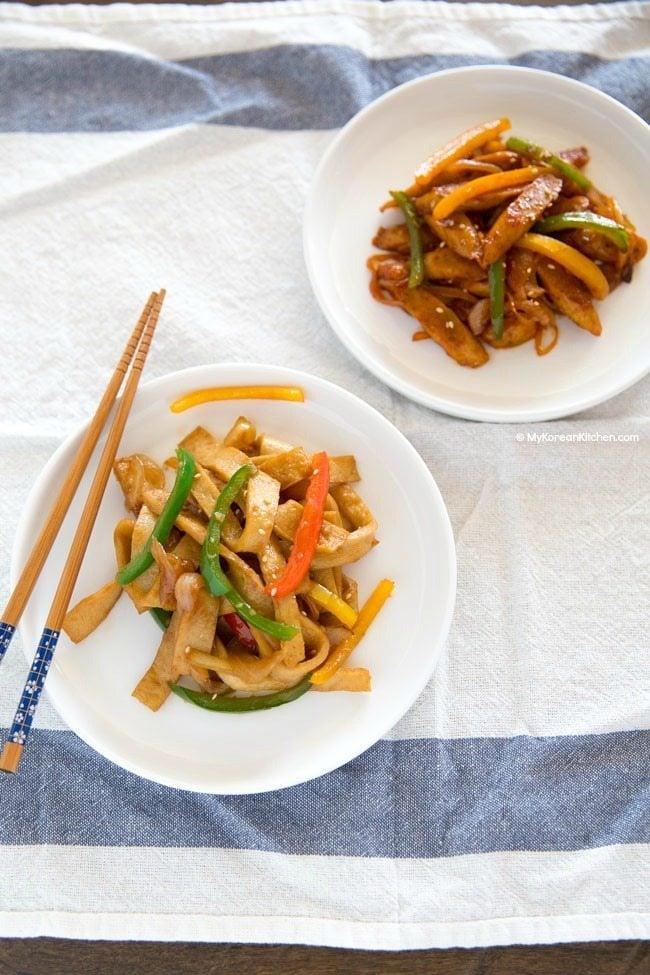
- Seasoned Dried Seaweed (Gim, 김) – Seasoned, dried seaweed (gim or nori) is a popular side dish for little kids. It has a crispy texture and is lightly seasoned with salt and sesame oil. Some adults might even have it as their drinking snack.
- Korean Steamed Egg (Gyeran Jjim, 계란찜) – At Korean BBQ restaurants, you may be served a side dish of steamed egg with a bowl of rice. The dish has a pudding-like texture, a slightly salty taste, and a savory flavor. It can help to reduce spiciness when eating spicy Korean BBQ.
- Haemul Pajeon (해물파전) – Pajeon is a savory and delicious Korean pancake dish that is perfect for any occasion. It is a great appetizer that will also fill you up.
- Corn Cheese (콘치즈) – Korean corn cheese is a delicious and popular dish made with corn, cheese, and mayonnaise. It is cooked over melted butter, so it has an amazing smell. It is often served as a side dish alongside Korean barbeque.

- Doenjang Jjigae (된장찌개) – Doenjang jjigae is a Korean stew made with doenjang (fermented soybean paste), vegetables, and tofu. It has a slightly nutty and savory taste, with an earthy undertone. It is commonly served with rice at the end of BBQ meals.
Rice & Noodles
A bowl of rice is a quintessential Korean dish, generally served with Doenjang Jjigae (Korean soybean paste soup) at Korean BBQ restaurants. Most restaurants serve plain white rice, but I prefer Purple Rice (흑미밥). Not only does it make for an attractive presentation, but it also has numerous health benefits compared to conventional white rice!
If someone would prefer noodles over rice, they can consider trying chilled buckwheat noodles. There are two types: Bibim Naengmyeon (비빔냉면), which comes with spicy seasoning, and Mul Naengmyeon (물냉면), which is served in a cold broth.

You may think that having another full meal after eating Korean BBQ is strange, but it is actually a great way to cool down after the hot BBQ and to wash off the greasy taste in your mouth.
How to Eat Korean BBQ
The traditional way to enjoy Korean BBQ is by making the “ssam”. This involves wrapping small pieces of meat in green leafy vegetables or pickled radish paper for a delicious dining experience. For neatness while enjoying, make sure to avoid making oversized wraps. It’s better to savor them in one bite!
To start, grill your Korean BBQ meat. If the pieces are too big for a single bite, cut them smaller using kitchen scissors.
Make bite-sized lettuce wraps by wrapping the meat in your choice of leafy vegetables; lettuce and perilla leaves are most common. I also like to layer pickled radish paper on top of the greens. Most Korean BBQ restaurants serve it as a complimentary side dish. You can buy the radish paper from a Korean grocer or easily make it at home.
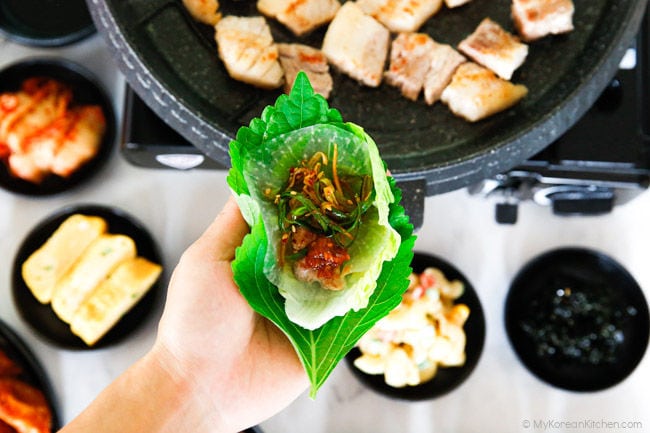
To add an extra layer of flavor, choose your favorite Korean BBQ dipping sauce and apply it to your wrap before devouring it. You will experience a burst of flavor with every bite, so repeat the process to enjoy it all over again!
Korean BBQ Etiquette
Although there are no hard-and-fast rules to observe when eating Korean BBQ, several surefire tips can help you make the most of your experience.
Eating with your hands is generally frowned upon, but it is acceptable when making lettuce wraps. Use chopsticks to transfer the meat and side dishes onto the wrap, but don’t hesitate to use your hands for wrapping and eating.
Also, please remember to consider others when dining together and make sure that everyone has enough food. Taking an excessive amount of meat and leaving little for others can be unpleasant for everyone. Many of my readers have complained about these table manners, which can spoil the enjoyment of Korean BBQ.
Which Korean Drinks to Pair with Korean BBQ
Koreans often drink alcohol when they have Korean BBQ. The two most popular drinks for this occasion are Soju (a distilled alcoholic beverage, 소주) and Maekju (beer, 맥주).

Sometimes people like to mix them together for an added kick: creating what’s called a ‘SoMaek (소맥)‘, which is a Soju + Maekju cocktail.
If you prefer a non-alcoholic drink, any kind of soda will work. Lemonade (사이다) and Coke (콜라) are the most popular options in Korea.
Notes
In 2015, I published an e-book titled “How to Enjoy Korean BBQ at Home Just Like a Restaurant.” Since then, I wanted to share the information in my book with more people, so I chose to convert it into a blog post.
Many parts of this post may be similar to the e-book; however, I have also added lots of new content to make it more comprehensive. I hope you find this article useful.
Love Korean food? Browse even more delicious ideas from my collection of easy Korean recipes. Don’t forget to subscribe to my newsletter to stay updated on new recipes, what the MKK community is cooking, and K-Dramas!

Your Ultimate Guide to Authentic Korean BBQ at Home
Ingredients
Korean BBQ Meat
- 1.2 - 1.5 kg bulgogi, boneless short ribs, pork belly, or chicken etc. (2.6 - 3.3 pound), see above for options
Vegetables
- 1 pack perilla leaves , rinsed and drained
- 2 heads Korean lettuce leaves , rinsed and drained
- 1 cucumber , cut into sticks
- 4-5 cloves garlic , thinly sliced
- 1/2 onion , thinly sliced
- 2-3 green chili , sliced
- 1 pack mushrooms , base cut off and separated
BBQ Dipping Sauce
- 4 servings ssamjang
- 4 servings wasabi and soy sauce
- 4 servings sesame oil, salt and pepper Sauce
Korean Side Dishes
- 4-6 types Korean side dishes (banchan) , see above for options
Rice
- 4 servings cooked rice , white or Korean purple rice
Equipment
- 1 Korean BBQ grill with portable gas burner or your choice of BBQ grill
- 2-3 tongs , to grill meat and vegetables
- 1-2 kitchen scissors
- 4 chopsticks
- 4 serving plates
Instructions
- Plan your Korean BBQ. If you are using marinated meat, marinate it according to the recipe; normally, this should be done the night before at least (see post for recipe suggestions). Prepare side dishes such as kimchi, pickled radish, and others; these can be bought from a Korean grocer or ideally made in advance. (Kimchi should be made at least one week prior, and other side dishes should be prepared 1-2 days before to save time on the day of barbecuing.)
- Set the table. Place the stove and grill plate in the center of the table. Set up your banchan (Korean side dishes), dipping sauces, and other ingredients on the table before cooking the meat so that, as it gets cooked, you can start eating right away. Place the serving plates and chopsticks for each individual, as well as the utensils, on the table.
- Grill. Turn on the stove and begin grilling your meat and your choice of vegetables. If cooking both non-marinated and marinated meat, try grilling the non-marinated meats first to minimize smoke and prevent the grill from burning too quickly. If the pieces of meat are too big for a single bite, cut them smaller using kitchen scissors.For vegetables, grill them on the edge of the grill as needed.To keep juice loss at a minimum, don’t flip the meat too much. Start moving the meat off the grill as it cooks or move it to the edge of the grill, so it cooks at a slower pace.
- Make "Ssam". Make bite-sized lettuce wraps by wrapping the meat in your choice of leafy vegetables; lettuce and perilla leaves are most common. Simply lay the lettuce flat and layer pickled radish on top of the greens, with grilled meat and dipping sauce on top, and gather the wrap for a bite.For neatness while enjoying, make sure to avoid making oversized wraps; it's better to savor them in one bite!
- Grill more meat, refill the side dishes and sauces as needed. Make more ssam, and enjoy!
Notes
The nutrition information shown is an estimate provided by an online nutrition calculator. It should not be considered a substitute for a professional nutritionist’s advice.
